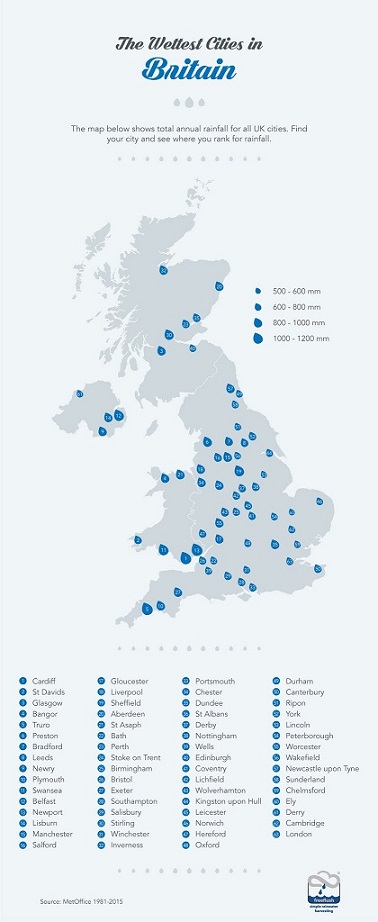
Which are the rainiest cities in the UK and why are they so wet?
Here’s the reason why the wettest parts of the UK are so, well, wet and why these places get more rain and flooding than others.
Basically, if you live in the west you’re going to get wet which is why Scottish and Welsh cities take the four top spots.
But why do these areas get such a drenching?
According to the Met Office: “The prevailing warm, moist, westerly winds mean the west of the UK is more likely to receive rainfall from Atlantic weather systems which usually move from west to east across the UK and as they do so the amount of rainfall they deposit reduces.
“This is because the mountains of the northern and western UK force the prevailing westerly winds to rise which cools the air and consequently enhances the formation of cloud and rain in these locations.”
According to the Met Office the rainiest parts of the UK are concentrated in mountainous regions with Snowdonia, the Lake District and the Scottish Highlands all receiving more than 4 metres of rainfall in a year. It means places you often associate with rain, such as Manchester, don’t even make the top 10.
Argyllshire tops the list with a soaking 2,274mm of rain each year and western areas in Scotland hold most of the top 10 spots with the exception of Merionethshire in Wales in at number 4 and Caernarvonshire at 6.
The highest listed English place is the north west county of Westmorland in at 9.
Cardiff is Britain’s wettest city with 1,152m m falling on it each year. Manchester comes in at 15 behind Belfast and Leeds. London is one of the driest at number 63 with a mere 557mm of rain.
So if you want to stay dry then move east to places like Cambridge, York and Lincoln with London probably the driest city in the UK even though it has suffered terribly from flash floods in 2021.
To find out more about the causes of flash flooding and why it can be so destructive click here.
The local north east rivalry between Newcastle and Sunderland remains as intense as ever with Sunderland just slightly drier than Newcastle.
By the way, the parts of the UK which see the most sunshine are Bognor Regis with 1,902 hours of sunshine per year, Eastbourne (1,888), Hastings (1,871), Isle of Wight (1,860) and Bristol (1,671). Bognor Regis, Eastbourne and Hastings are all in Sussex.
But when it’s wet in the UK it can be really wet with flash flooding always a risk which is why many homes and businesses now have FloodSax sandless sandbags for flood protection so they are prepared 24/7 to reduce their chances of flood damage. FloodSax are transformed from being as light as a pillowcase to being more effective than traditional sandbags in just three minutes and are ideal at soaking up spills as well as stopping any floodwater.
Around 2.5 million have now been sold worldwide for flood resilience, flood protection and flood control.
The full list of Britain’s cities and where they are in the UK’s rainfall chart is:
- Cardiff
- St David’s in South Wales
- Glasgow
- Bangor
- Truro
- Preston
- Bradford
- Leeds
- Newry, Northern Ireland
- Plymouth
- Swansea
- Belfast
- Newport
- Lisburn, Northern Ireland
- Manchester
- Salford
- Gloucester
- Liverpool
- Sheffield
- Aberdeen
- St Asaph, North Wales
- Bath
- Perth
- Stoke-on-Trent
- Birmingham
- Bristol
- Exeter
- Southampton
- Salisbury
- Stirling
- Winchester
- Inverness
- Portsmouth
- Chester
- Dundee
- St Albans
- Derby
- Nottingham
- Wells, Somerset
- Edinburgh
- Coventry
- Lichfield
- Wolverhampton
- Kingston-upon-Hull
- Leicester
- Norwich
- Hereford
- Oxford
- Durham
- Canterbury
- Ripon
- York
- Lincoln
- Peterborough
- Worcester
- Wakefield
- Newcastle
- Sunderland
- Chelmsford
- Ely, Cambridgeshire
- Derry
- Cambridge
- London